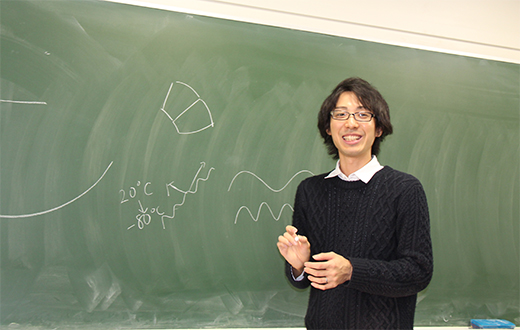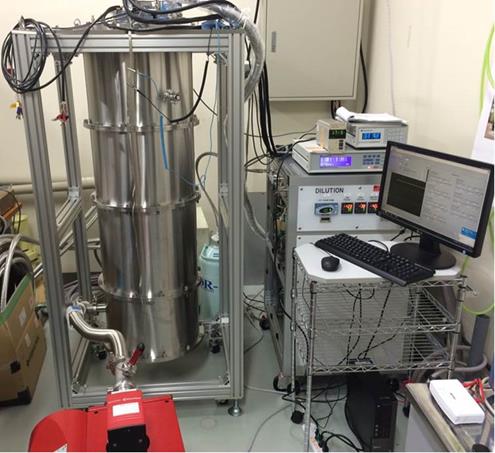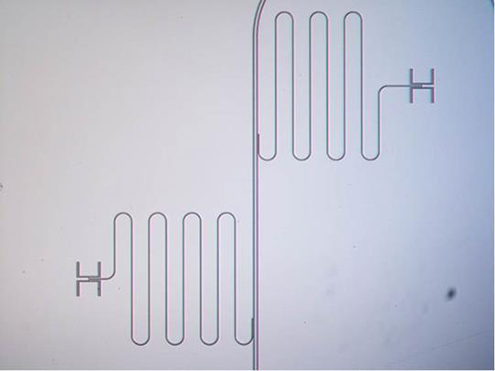TSUKUBA FUTURE
#068 Pursuing the Dream of Searching for the Birth of Galaxies—in the Antarctic
Assistant Professor NITTA Tomu, Faculty of Pure and Applied Sciences
TSUKUBA FUTURE #068

The universe is roughly 13.8 billion years old and is considered to have been expanding constantly for this entire time. Photos of spiral galaxies taken by telescopes inspire awe at the immensity of the universe and its innumerable galaxies. Distant galaxies observable by visible light make up only a fraction of the estimated total number of existing galaxies. In order to observe distant galaxies that emit light in the terahertz/submillimeter wavelength, researchers aim to set up a radio telescope in the Antarctic.
University of Tsukuba is engaged in a project to set up a radio telescope with a diameter of 10 meters in the Antarctic region. Why the South Pole, of all places? The Subaru Telescope of the National Astronomical Observatory of Japan is located atop Mauna Kea on the island of Hawaii at an elevation of 4,205 meters. The ALMA (Atacama Large Millimeter/submillimeter Array) telescope stands upon the Atacama plateau in northern Chile at an elevation of 5,000 meters. These locations have harsh environments.
Why are they chosen as locations for telescopes? Because to observe the universe in visible light certain conditions must be met—a high percentage of cloud-free days and an atmosphere that does not interfere with the light reaching the Earth from the stars. To avoid interference from the atmosphere, another method exists, and that is to launch a telescope into space. NASA's Hubble Telescope, launched in 1990, is just such a telescope. When building a telescope observatory on the ground, a high-altitude location where the air is thin is a prerequisite, such as atop Mauna Kea—the Subaru Telescope. Such location choices are made to suit the requirements for the wavelength of light to be observed.
To go into more detail, stars are formed from low-temperature cosmic dust particles in a galaxy that emits infrared light (dust radiation). An infrared telescope is used to detect the infrared radiation being emitted by cosmic dust in distant galaxies. But newly-formed galaxies that are even more distant and which contain enormous quantities of stardust still cannot be observed by their infrared rays. Because of the expansion of the universe, the infrared light has been stretched out and shifted into terahertz waves (THz: a unit of frequencies; 1 THz = 1012 Hz with a wavelength of 0.3 mm) or submillimeter waves (an electromagnetic wavelength range from 1 mm to 0.1 mm; a wavelength of less than 0.3 mm is called a terahertz wave).
These wavelengths of light (technically, electromagnetic waves) can now be observed, which should make it possible to "see" galaxies that are incredibly far away. However, a problem still remains. Terahertz and submillimeter waves are absorbed by moisture in the atmosphere, making them difficult to detect from the ground. High altitudes are drier than lower altitudes, though, and the Atacama plateau is in a desert region. The ALMA telescope located is therefore one facility able to detect and measure the millimeter and submillimeter waves emitted by various celestial bodies, including distant galaxies. In fact, there is another place on Earth that is even drier than the Atacama plateau: the Antarctic, which is a frozen desert with a low-moisture atmosphere due to the sub-freezing temperatures.

Prof. Nitta belongs to the University of Tsukuba Radio Astronomy Lab team that aims to build a terahertz telescope in Antarctica. He himself is working on developing the telescope. Prof. Nitta has been watching the stars through telescopes since he was a boy; it is something he truly loves to do. This compelled him to visit the research lab, and he found that the team truly enjoys working to develop devices to observe distant galaxies. There was never a doubt that Prof. Nitta would join this research team. And what he encountered when he did was a plan set in motion by Professor Naomasa Nakai—the "Antarctic 10-Meter-Class Terahertz Telescope Plan."
The air is clear and dry atop Mauna Kea and upon the Atacama plateau, yet terahertz wavelength observation is still difficult to perform in those places. Because it is also dry in Antarctica, particularly the inland Antarctic Plateau, this location is the only spot on the planet where high-sensitivity terahertz wave observation is possible. Moreover, the site chosen for the telescope—Dome C, a joint French/Italian scientific base at an elevation of 3,260 meters—is cloud-free 80% of the year. If terahertz wave observation becomes possible here, the ability to discover extremely faraway galaxies in the universe will no longer remain a dream. And because of the great distance the light waves must travel from faraway galaxies, we are actually seeing those galaxies not as they are today but as they were billions of years ago, very close to their birth.
In this grand scheme, the mission entrusted to Prof. Nitta is the development of a radio wave camera for detecting electromagnetic waves in the terahertz band. The camera employs an array of superconducting detectors that uses helium gas chilled to 0.1 Kelvins (absolute zero is -273.15°C, while 0.1 Kelvins is -273.05°C). The radio wave camera is composed of numerous detectors about 1 mm in size lined up together. The immediate goal is to set up the telescope on site in six years. Prof. Nitta speaks with great enthusiasm about developing this monitoring device. What exists far out in the distant universe that this Antarctic telescope will discover?

The radio wave camera under development. Inside the stainless steel pipe are lenses and other optical components, along with the superconductive detector, which uses helium gas cooled to 0.1 K.

A microscopic image from a superconducting detector (2 elements). The H-shaped structures are antennae, while the snaking parts are the detectors. One element is about one millimeter in size. The light areas are thin film aluminum and the dark areas silicon substrate.
Article by Science Communicator at the Office of Public Relations


